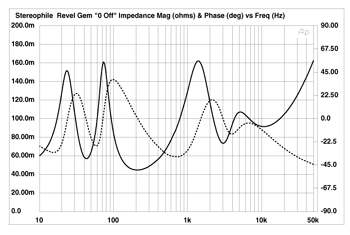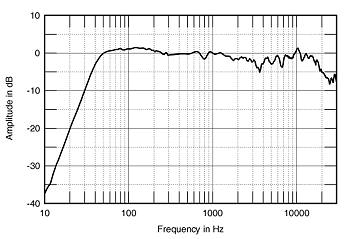| Columns Retired Columns & Blogs |
Revel Home Theater (SGHT Review) Measurements
Measurements
John Atkinson performed the measurements on the Revel Gem and Voice. The main review presented here was completed prior to my seeing any test results. All of the measurements were made with the grilles and wood trim panels in place.
John Atkinson performed the measurements on the Revel Gem and Voice. The main review presented here was completed prior to my seeing any test results. All of the measurements were made with the grilles and wood trim panels in place.
Starting with the Gem, its sensitivity is 87.6dB/W/m (B-weighted), a reasonably average value for consumer loudspeakers. (For comparison, this is about 1-2dB less than you might see with a loudspeaker designed for THX certification.) The impedance varies slightly with the tweeter settings, but the plot of Fig.1, with the main tweeter set at "0dB," is typical of the result with the rear tweeter turned off. This is a comparatively easy load, with a minimum impedance of about 4.5 ohms. With the front tweeter at +1dB and the rear tweeter set to +4dB (worst case—curve not shown), the impedance drops below 4 ohms above 10kHz and reaches a minimum of approximately 2.5 ohms at 18kHz. The latter should not be a problem for the sort of amplifier likely to be used with these loudspeakers. The Gem's ported enclosure is tuned to just above 40Hz.

Fig.1 Revel Gem, electrical impedance (solid) and phase (dashed) (2 ohms/vertical div.).
Fig.2 shows the on-axis response averaged across a 30-degree lateral window combined with the nearfield response of the woofers (front tweeter at 0dB, rear tweeter off). This is a very flat response, with only a slight dip near 4kHz and a slight excess in the 10kHz region—the latter perhaps explaining why I most often preferred the Gems with the tweeter-level control set to "-2dB." The slight ripples visible in the tweeter's response—which should not have audible consequences—are apparently due (according to JA's analysis) to the side lips of the cabinet, which extend forward of the front baffle at the top and bottom. The action of this tweeter control is roughly as advertised: the +1 setting boosts the top end by very close to +1dB from 3kHz to about 17kHz; -2 results in approximately -1.5dB from 3kHz to 6kHz and about -2dB from 9kHz to 20kHz. The rear tweeter, when switched in, has a reasonably linear but rising response from about 2kHz to 17kHz.
The horizontal dispersion of the Gem shows a very smooth rolloff to the sides, with good off-axis response to well above 10kHz. A slight excess in the off-axis energy at 3-4kHz should help fill in the small on-axis dip seen at that frequency in Fig.2. Vertical dispersion remains smooth at reasonable ear-heights—within a few inches of the tweeter axis. When the listener is significantly displaced vertically from the tweeter axis, suckouts start to appear in the upper midrange/low-treble response—a very common phenomenon in the vertical, off-axis performance of multi-driver loudspeakers. (While the Gem can be used as a center-channel loudspeaker instead of the Voice, do not use it on its side if you expect the best performance from off-center listening positions.)
The Gem has good impulse and step responses (though, like most loudspeakers, it is not time-coherent). Its delayed resonances are well-controlled.

Fig.2 Revel Gem, anechoic response on tweeter axis at 50", averaged across 30° horizontal window and corrected for microphone response, with complex sum of nearfield woofer and port responses plotted below 300Hz.
- Log in or register to post comments




































